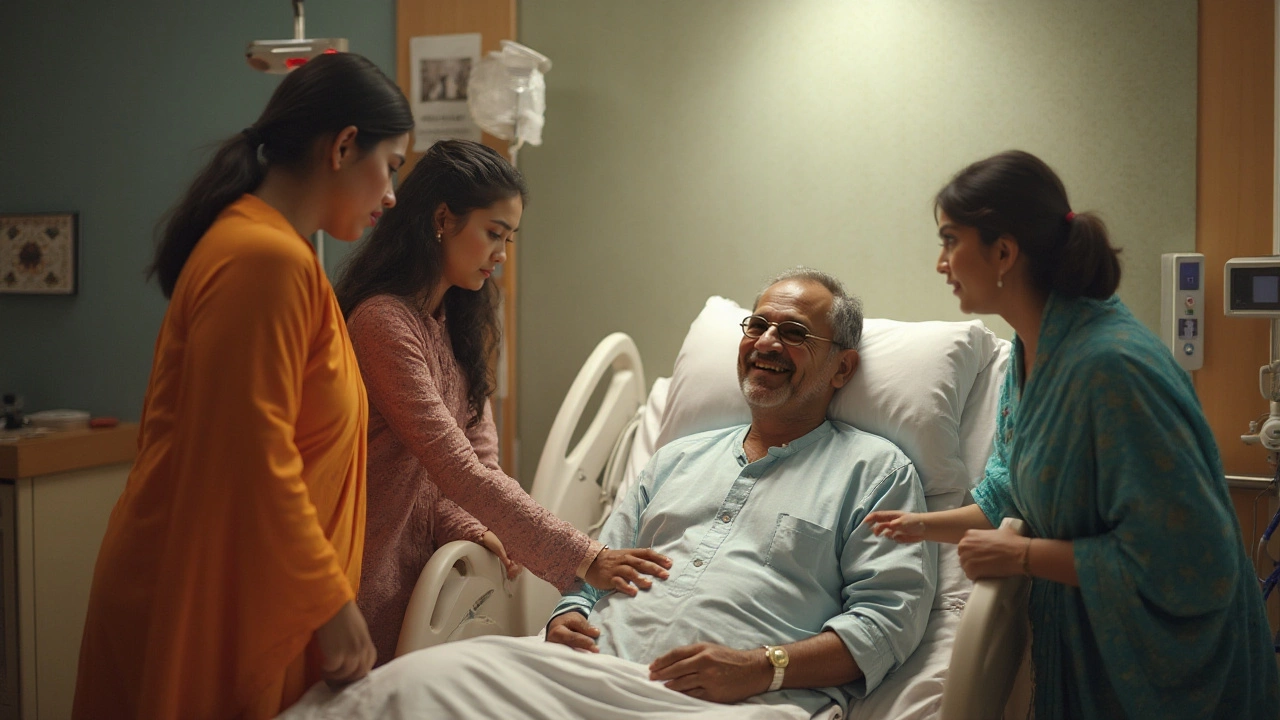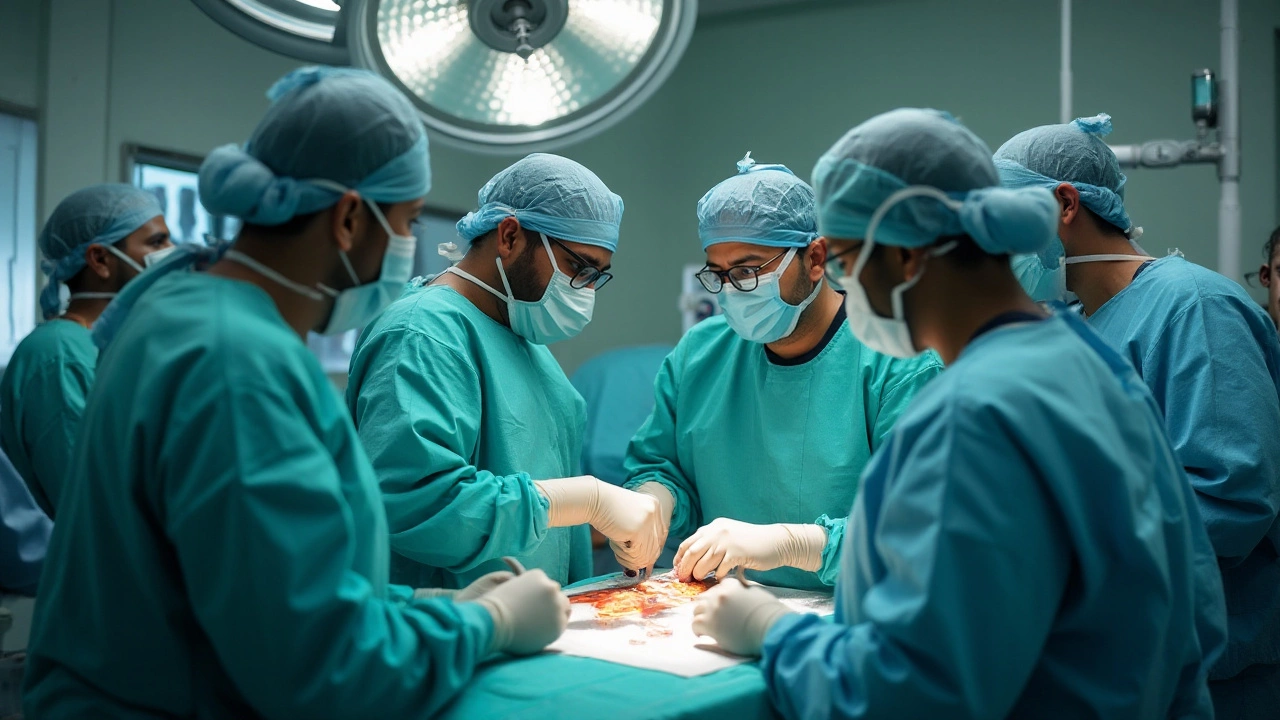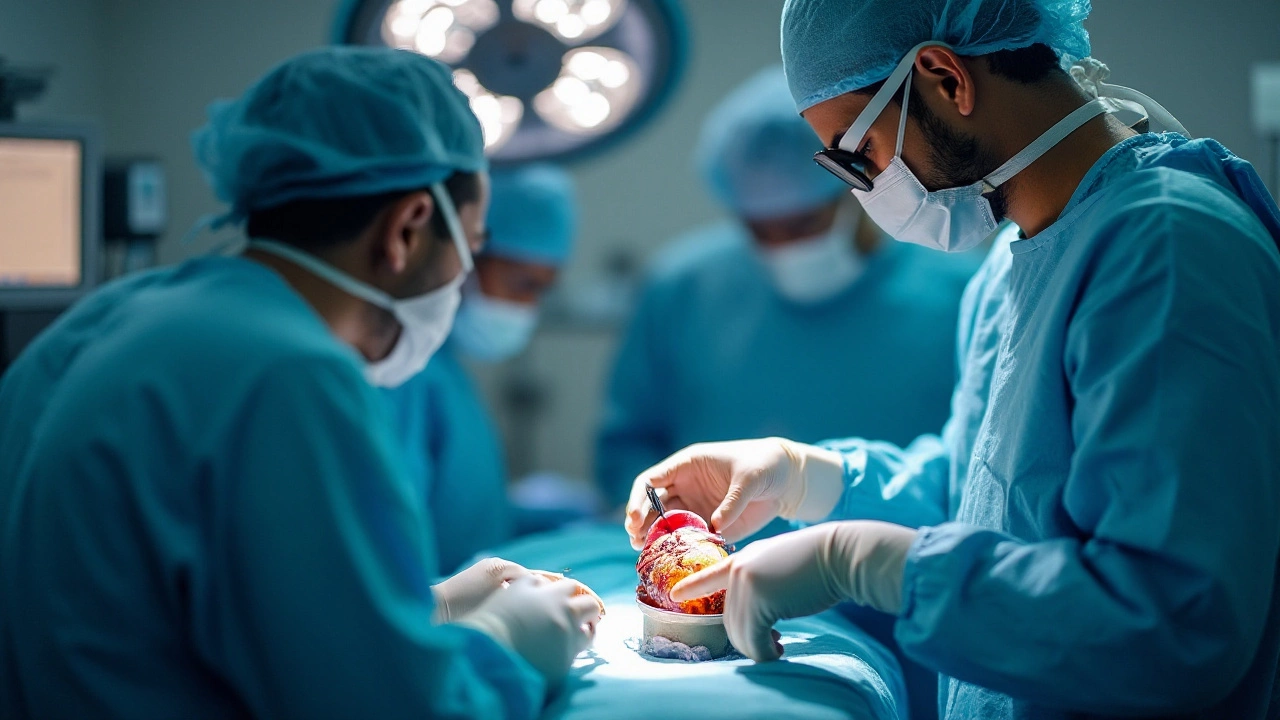Heart surgery can sound daunting, yet it serves as a life-saving intervention for many. Doctors across the globe regularly perform these operations, tackling complex heart conditions with remarkable precision. As we dive into this topic, you'll find that advancements in medical science have paved the way for diverse surgical options, catering to various needs.
Whether through traditional open surgeries or the cutting-edge minimally invasive techniques, understanding these procedures can empower patients and their families. As medical technologies evolve, the landscape of heart surgeries continues to change, promising new solutions and outcomes. Let's explore the world of heart surgery, shedding light on its different forms and what lies ahead.
- Coronary Artery Bypass Grafting (CABG)
- Heart Valve Repair and Replacement
- Pacemakers and Implantable Cardioverter Defibrillators
- Minimally Invasive Procedures
- Recovery and Future of Heart Surgery
Coronary Artery Bypass Grafting (CABG)
Coronary Artery Bypass Grafting, or CABG, is perhaps the most well-known type of heart surgery, aimed at tackling blocked coronary arteries. The surgical process involves creating a new pathway around the clogged arteries to improve blood flow to the heart. Surgeons typically use a healthy blood vessel taken from another part of the patient’s body, like the leg or chest, to form this bypass. By offering a renewed route for blood flow, CABG plays a crucial role in reducing symptoms of coronary artery disease, such as chest pain and shortness of breath, and in lowering the risk of heart attacks.
Once diagnosed with severe coronary artery disease, a patient may be referred for this procedure. The decision often depends on the number of arteries affected and the severity of the blockages. Before surgery, the healthcare team performs an extensive evaluation, sometimes involving coronary angiography, to map the blocked arteries. During CABG, the patient is generally under general anesthesia, and the surgery can last several hours.
There has been significant progress in CABG techniques over the years. Some patients benefit from minimally invasive methods, which avoid opening the chest entirely, thereby reducing recovery time. In certain cases, surgeons opt for multiple bypasses depending on how many arteries are blocked. The recovery process typically involves a stay in the hospital for observation, where medical professionals monitor heart function and ensure that the grafts are working correctly.
"With CABG, we're not just extending life but also enhancing quality of life for many patients." — Dr. John P. Doe, Chief of Cardiology at Heart Health Institute.
The success and safety of CABG have been well established, but like any major surgery, it carries potential risks, such as infection, bleeding, or complications due to anesthesia. Patients often engage closely with their healthcare providers post-surgery to monitor their recovery and make necessary lifestyle changes, such as adopting a heart-healthy diet and incorporating regular exercise. These steps not only aid recovery but also ensure the longevity of the surgery's benefits. Knowing what heart surgery options are available and understanding the expectations and outcomes can be empowering for both patients and their families.
Heart Valve Repair and Replacement
In the realm of heart surgery, focusing on heart valve repair and replacement is crucial for maintaining the cardiac system’s functionality. The heart contains four valves that ensure blood flows properly: the aortic, mitral, tricuspid, and pulmonary valves. Each valve opens and closes in a rhythmic cycle, directing blood flow in one direction. However, when these valves malfunction due to congenital defects, infections, or age-related changes, they need medical intervention.
Heart valve repair is often preferred by surgeons whenever feasible, as preserving the patient’s natural tissue has numerous benefits. Different techniques, such as repairing a torn leaflet or reinforcing the valve with a ring, come into play. On the other hand, replacement becomes necessary when repair is not viable. Patients can receive mechanical valves, which are durable but require lifelong anticoagulation medication, or biological valves from animal tissue that generally last 10 to 20 years but do not require such medication.
Deciding between repair and replacement involves considering several factors, such as the patient’s age, the severity of the condition, and lifestyle preferences. For younger patients, repair might be more suitable as it retains tissue, while older patients can benefit from replacement due to its less complex nature. According to the American Heart Association, around 2.5% of the U.S. population has a valvular heart disease, highlighting the need for these crucial procedures.
"Repairing a heart valve is always our first choice when possible, as it offers better long-term outcomes," says Dr. Edward Chen, a renowned cardiac surgeon.
In recent years, technological advances have broadened the options for heart valve surgery. Minimally invasive techniques have emerged, allowing for smaller incisions and quicker recovery times. Innovations like the transcatheter aortic valve replacement (TAVR) provide alternatives for patients who are at higher surgical risk, showcasing a significant shift in cardiac procedures toward less invasive methods.
The importance of early diagnosis cannot be overstated. Regular check-ups and echocardiograms can help catch issues before they exacerbate. With proper management and timely intervention, many can maintain good heart health while lowering complications. As research continues and technologies evolve, the future of heart valve surgery remains promising, potentially leading to the development of new materials or regenerative options that might even eliminate the need for replacement altogether.

Pacemakers and Implantable Cardioverter Defibrillators
In the realm of heart surgery, pacemakers and implantable cardioverter-defibrillators (ICDs) have become vital tools for maintaining heart health. These devices help regulate heartbeats and are crucial for patients with certain cardiac conditions, offering a lifeline to those who experience irregular heart rhythms. Pacemakers are small devices placed under the skin near the heart, using electrical impulses to prompt the heart to beat at a regular pace. This approach effectively manages arrhythmias, a condition characterized by an abnormal heartbeat, keeping the rhythm within a normal range. Interestingly, pacemakers have evolved over time, becoming more compact and efficient, significantly improving the quality of life for patients around the world.
ICDs, on the other hand, are more intricate devices designed for patients at risk of sudden cardiac arrest. While they function similar to pacemakers in that they are implanted under the skin, their primary role is to continuously monitor heart rhythms and deliver life-saving shocks when dangerous arrhythmias, such as ventricular fibrillation, are detected. These life-saving shocks are often the difference between life and death in critical moments. Over the years, advancements in technology have enhanced the precision and capabilities of ICDs, allowing them to offer more personalized therapies and comprehensive monitoring for patients.
"The evolution of cardiac devices like pacemakers and ICDs has revolutionized how we approach cardiac care, providing patients with more tailored and effective treatments," says Dr. Emily Rogers, a renowned cardiologist.
The process of implanting these devices is relatively straightforward and has become a routine procedure in many hospitals. Doctors make a small incision near the shoulder, through which the device is inserted and connected to the heart with one or more leads. These leads play a critical role as they relay the heart's electrical activity back to the device, allowing it to make real-time adjustments as necessary. Recovery time is usually quick, with most patients returning to normal activities within a few weeks. It's fascinating to see how these devices seamlessly blend into patients' lifestyles, offering them freedom and peace of mind.
The benefits of pacemakers and ICDs extend beyond just monitoring heart rhythms; they also come equipped with features that enable remote monitoring. This means patients can have their device checked from home, adding a layer of convenience and safety. Health professionals can analyze data from these devices remotely, ensuring timely interventions when necessary. This significant development in cardiac care allows timely adjustments to treatment plans, enhancing the overall efficacy of these devices. As technology continues to advance, both pacemakers and ICDs are likely to continue offering more sophisticated features, potentially integrating with other emerging technologies to provide comprehensive heart care solutions.
| Device | Main Function | Commonly Used For |
|---|---|---|
| Pacemaker | Regulates heartbeats | Bradycardia, arrhythmias |
| ICD | Delivers shocks to return heart to normal rhythm | Ventricular fibrillation, tachycardia |
In conclusion, the role of pacemakers and ICDs in the field of heart surgery is indispensable, providing life-saving interventions to countless individuals worldwide. These devices symbolize the marriage of medicine and technology, exemplifying how innovation can drastically improve patient outcomes. As research and development continue to push the boundaries, one can only anticipate more exciting possibilities on the horizon, further enhancing our capability to combat heart-related illnesses effectively.
Minimally Invasive Procedures
Minimally invasive procedures are at the forefront of modern heart surgery, providing patients with options that require smaller incisions and often result in quicker recovery times. These techniques represent a significant move away from traditional open-heart surgery, offering effective solutions with less trauma to the body. In recent years, technological advancements have opened the door to this less invasive approach, making it accessible to an increasing range of cardiac issues.
One of the most notable methods is the minimally invasive direct coronary artery bypass (MIDCAB). This technique relies on smaller cuts, typically between the ribs, to reach the coronary arteries. Unlike the more conventional coronary artery bypass grafting (CABG), MIDCAB does not require opening the chest, thus allowing patients to experience less postoperative pain and reducing the risks of infection.
Transcatheter Aortic Valve Replacement (TAVR)
This procedure is a groundbreaking option for patients who need aortic valve replacement but are at high risk for open-heart surgery. TAVR is conducted through a catheter, usually inserted into a blood vessel in the groin. With this method, the new valve is placed within the old, diseased valve, making the process not only less invasive but also incredibly efficient. According to the American Heart Association, "The number of TAVR procedures has increased dramatically since its inception, highlighting its growing acceptance among cardiologists."Robotic-Assisted Surgery
Another fascinating advancement is robotic-assisted heart surgery. This approach permits surgeons to utilize a computer console to control surgical instruments attached to robotic arms. The precision and flexibility offered by this technology allow for enhanced dexterity and the ability to operate on hearts with intricate anatomical characteristics. While this type of surgery is less common, its benefits, such as reduced blood loss and shorter hospital stays, are undeniable, making it an important option for suitable candidates.These minimally invasive techniques not only facilitate a faster recovery but often mean fewer lifestyle disruptions for patients. Where traditional heart surgeries might require weeks of downtime, patients undergoing minimally invasive procedures often return to daily activities much faster. According to recent findings, nearly 70% of patients can resume regular activities within a few weeks, underscoring the efficiency of these methods.
Advancements in the field also mean that complications from minimally invasive heart surgeries are becoming rarer, with studies showing a marked decrease in associated risks. As practitioners continue to refine these techniques, the potential of minimally invasive heart procedures holds great promise for future treatments in cardiac care. The realm of heart surgery is indeed transforming, offering hope and enhanced quality of life to those who need it most.

Recovery and Future of Heart Surgery
The recovery from heart surgery is a journey, not just a destination. This period demands attention to detail and dedication to improving one's health. Initially, patients might feel overwhelmed by the changes their body has gone through and the adjustments required in their lifestyle. It is common to spend several days in the hospital after the procedure, where the medical team ensures that all vital signs are stabilized. Consistent monitoring and care set the stage for a smoother transition back home. During this time, patients are encouraged to start moving as soon as possible, as this aids in fending off potential complications. Also, a tailored rehabilitation program often follows hospital discharge, focusing on restoring strength and ensuring a return to daily activities.
Nutritional adjustments become paramount during recovery. A heart-healthy diet, abundant in fruits, vegetables, lean proteins, and low in saturated fats, fosters healing and prevents future complications. The care doesn't end with diet change; many doctors emphasize the need to keep hydrated and avoid overly caffeinated or sugary drinks. Building a support network is equally vital. Engaging with others who have undergone similar experiences often provides encouragement and helpful tips. Family and friends play a crucial role, offering emotional support and assisting with day-to-day tasks, thus aiding in the patient's positive outlook on recovery. Mental health remains just as important as physical recuperation, with some individuals benefiting from counseling or support groups.
Looking to the future, the realm of heart surgery teems with innovation. The prospect of increasingly minimally invasive procedures brings hope for even faster recoveries and reduced hospital stays. Robotics and AI are set to lead change, offering precision that was once unimaginable. Data from respected sources indicate that minimally invasive methods, where applicable, have decreased the recovery time by nearly half, as shown in recent studies. This advancement potentially reduces the psychological and physical burdens traditionally associated with surgery. Moreover, personalized medicine is paving the way for individualized treatment plans that cater to each patient's unique genetic makeup, promising a revolution in effective care.
"The future of heart surgery looks bright with technological breakthroughs enhancing precision and expanding possibilities," states Dr. Emily Tran, a leading cardiothoracic surgeon.
As researchers strive to develop new techniques, the integration of smart technology in postoperative care is another area to watch. These technologies can monitor biological signals in real-time, providing clinicians with invaluable data that could preemptively address complications. This synergy of traditional medicine with modern technology not only paves the way towards better outcomes but also enriches the patient experience. Educational resources are also expanding, enabling patients to become proactive partners in their own care journey. To conclude, the effort that goes into recovery and the promising future of heart surgery requires collaboration between medical professionals and patients, ensuring that heart health remains robust and resilient.

 Herbs That Harm Your Kidneys: What to Avoid for Better Kidney Health
Herbs That Harm Your Kidneys: What to Avoid for Better Kidney Health
 Understanding Knee Pain: When is Knee Replacement Necessary?
Understanding Knee Pain: When is Knee Replacement Necessary?
 Does Medicare Cover You If You Travel Overseas? Know Before You Go
Does Medicare Cover You If You Travel Overseas? Know Before You Go
 Kelly Clarkson's Rapid Weight Loss Journey: Secrets and Tips
Kelly Clarkson's Rapid Weight Loss Journey: Secrets and Tips
 What Is a Vata Person Like? Ayurvedic Traits, Behaviors, and Daily Balance Tips
What Is a Vata Person Like? Ayurvedic Traits, Behaviors, and Daily Balance Tips